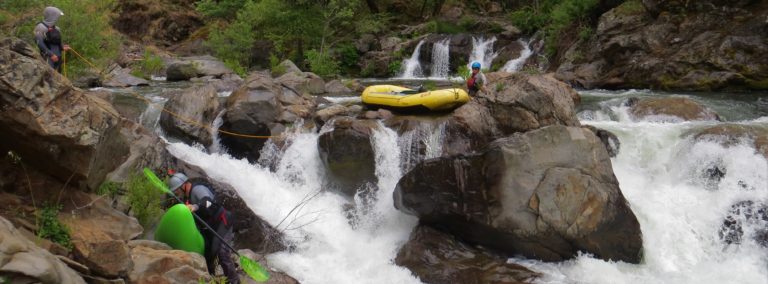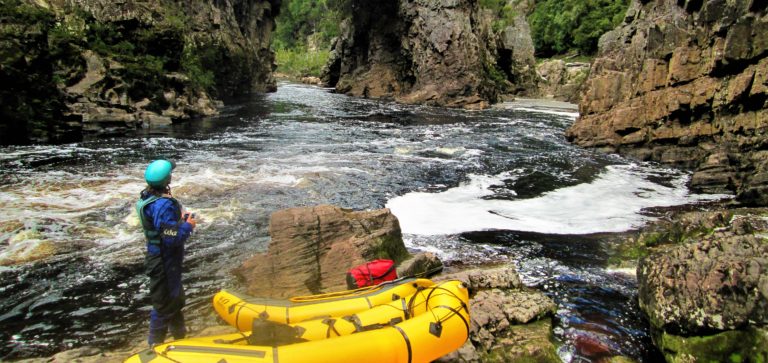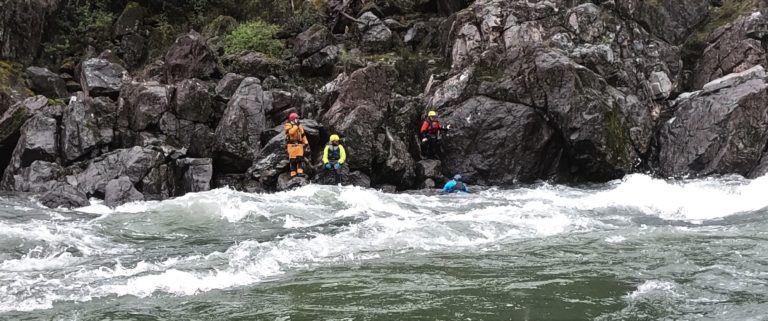The three main ways to rig (tie-down) equipment are cam-straps, rope and webbing. While cam-straps have made knowing knots less necessary many times it is still easier to use rope or webbing. Below are the rafting knots I use most often along with videos of how to tie them.
Rope versus Webbing
In general ropes are easier for tying knots and pulling but webbing is much stronger for the cost. Most bow and stern lines are rope while most rescue lines are webbing except for the haul-line being pulled. Certain knots are better suited for webbing than rope while other knots are vice versa. This is particularly true with water knots being used primarily with webbing and the figure 8 family of knots being used with rope.
Raft Bow and Stern Line Coils
When coiling lines start near the affixed end to prevent the rope from becoming twisted (In another video Zach from the video below acknowledges that he would be better off coiling by starting at the end attached to the raft). Smaller coils are better for entrapment concerns but can become bulky and difficult to manage. Coiling around the hand and elbow works well for shorter, smaller diameter bow and stern lines.
Leave enough rope out of the coil so the coil can rest inside the raft (I differ from the video here as well). This way you know the coil isn’t dragging in the water where it will loosen up over time, come undone and potentially get chalked in some rocks. Having an arms length of rope out of the coil also makes it easier for someone to quickly jump off the raft and hold the boat on shore. Sailors do something similar called a figure 8 coil knot.
Half hitches on a bite
When tying the raft to shore pull a bite of rope around the tree or rock and then use two or 3 half hitches with a 3+ inch tail. by pulling a bit of rope around the tree you save all the time of trying to get the whole line around the tree and then pulling it back around when untying the raft.
Two half hitches is enough but if your nervous tie a third. Half hitches are nice because they are easy for anyone to untie quickly. There are cool quick release knots that can be used to tie of rafts. Unfortunately, too often when someone other than the person who tied the knot unties it, the knot is undo incorrectly creating a time consuming mess. Getting a bow line untied quickly can be a safety issue if needing to affect a rescue.
Family of Water Knots
These knots work well with webbing but are not recommended for rope. Make sure the tails are at least 3 inches long. Works well for creating a loop at the ends of a piece of webbing or to make one large loop. The figure-8 knots can be also used but it is typically more difficult to undo a figure-8 in webbing.
Figure 8
Excellent for permanently tying a bowline to a raft or using on the end of a throw bag or longline. This is also one of the most important rafting knots for rescue systems.
Bowline + Quick Release Bowline
The bowline knot is ideal for attaching a bowline to your raft. The knot holds better over time than half-hitches. Even after being wet and dry with force applied to it many times, the knot can be undone with some work. The quick release bowline can be undone much more quickily. This is also works nicely to create a fixed loop on one end of a rope to use like a camp strap that is tied off with a quick release half-hitch. A quick release is also know as a slipped knot but not a slip knot.
Truckers hitch (& GE Knot)
The trucker’s hitch comes in handy any time you want to get tension on a line. In the video he uses a GE knot, a good alternative to the bowline) to tie off the initial end of his rope. If I’m leaving the rope loose for periods of time and then retying the trucker’s hitch I find a bowline holds up better than the GE knot. The key step in the trucker’s hitch is being sure to lock off the knot so it will not easily come undone.
Butterfly Knot
Useful for a self-equalizing system using a throw bag or long-line. Butterfly knots can be pulled on in either direction.
Concluding Thoughts on Rafting Knots
The first 5 rafting knots ( coils, half hitches, water knot, figure 8, bowline) will get about everything done when rigging and running rivers. If you prefer to rig using webbing over cam straps than the trucker’s hitch is also necessary. Here are a few rescue knots that are also helpful to know if you have to deal with a wrap: Prusik knot, Double fisherman’s knot, No-knot.


